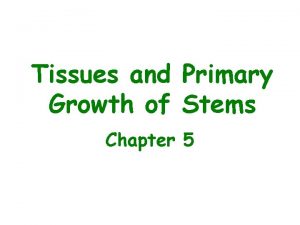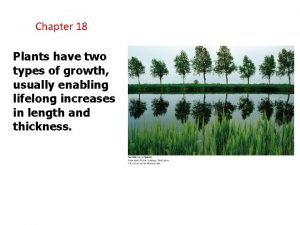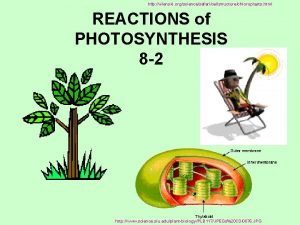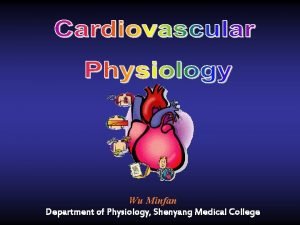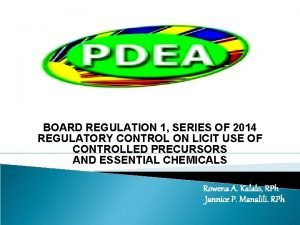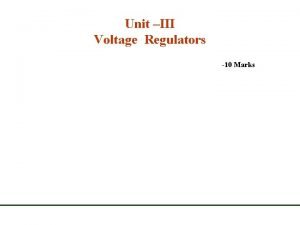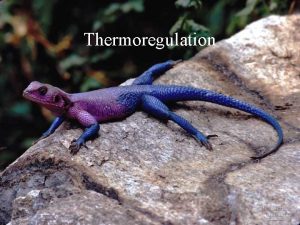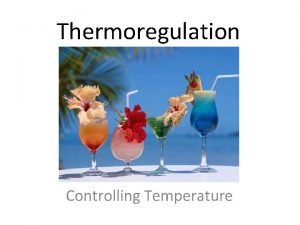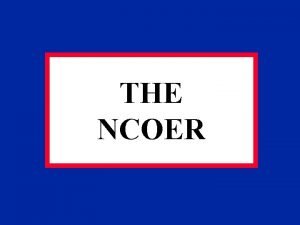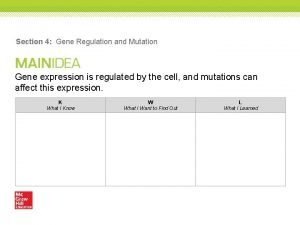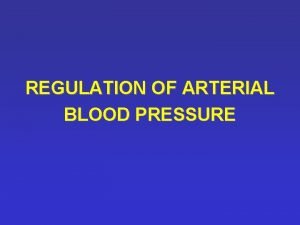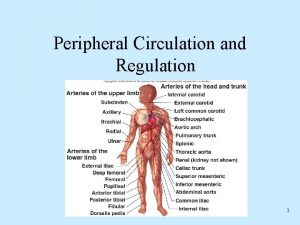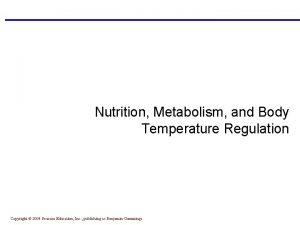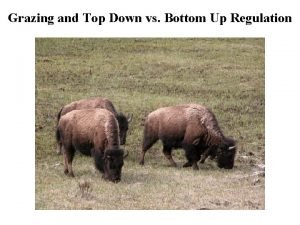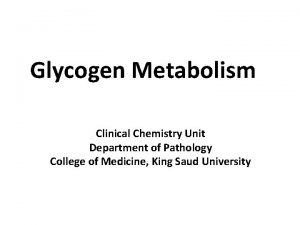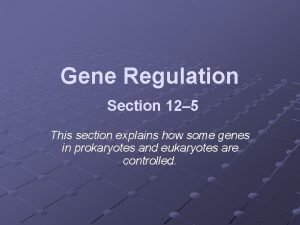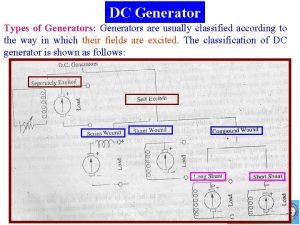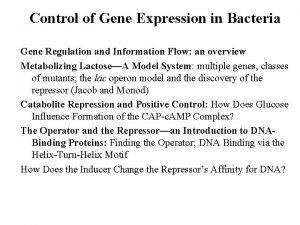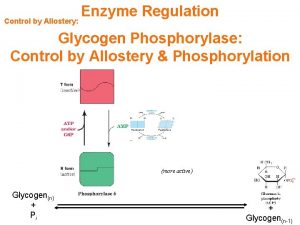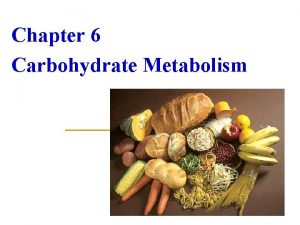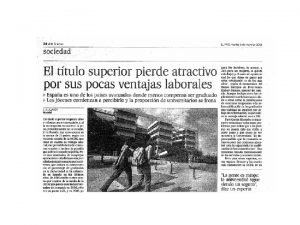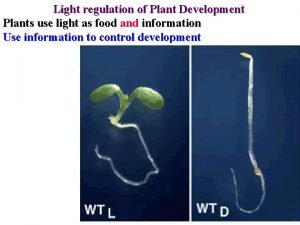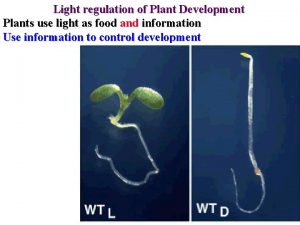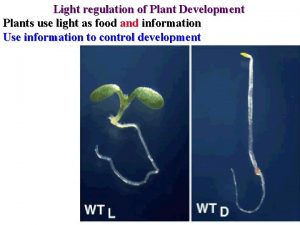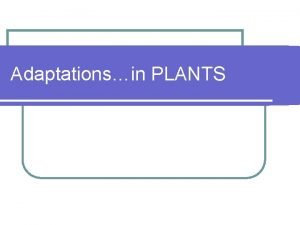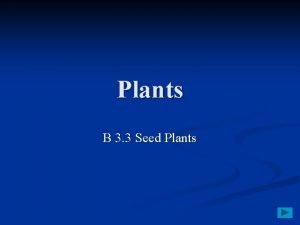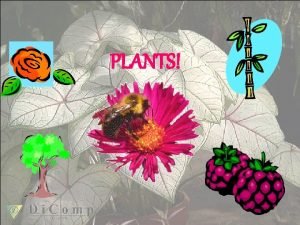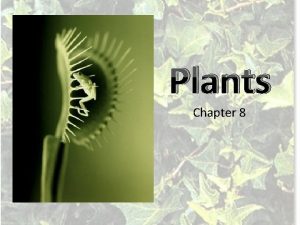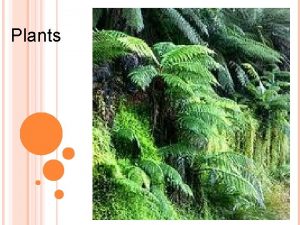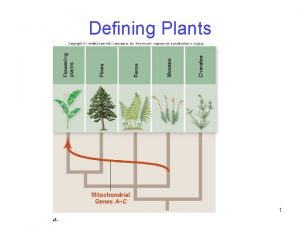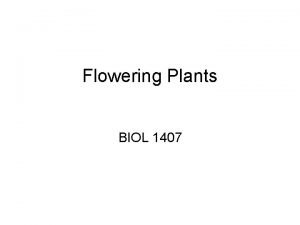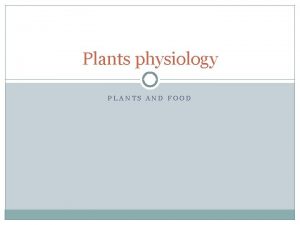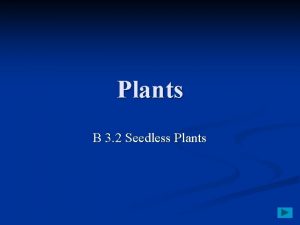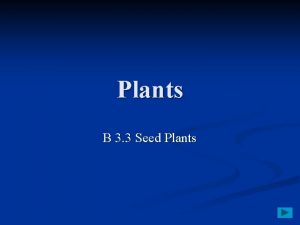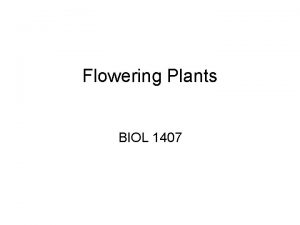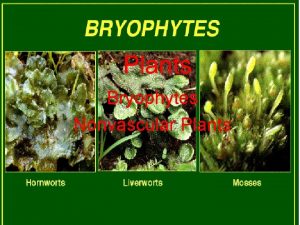Light regulation of growth Plants sense 1 Light












































































- Slides: 76

Light regulation of growth Plants sense 1. Light quantity 2. Light quality (colors) 3. Light duration 4. Direction it comes from

Types of Phytochrome Responses Two categories based on speed 3 classes based on fluence (amount of light needed)

Circadian rhythms Many plant responses show circadian rhythms • Once entrained, continue in constant dark, or light! • Gives plant headstart on photosynthesis, other processes that need gene expression

Circadian rhythms Light & TOC 1 activate LHY & CCA 1 at dawn LHY & CCA 1 repress TOC 1 in day, so they decline too At night TOC 1 is activated (not enough LHY & CCA 1) Phytochrome entrains the clock So does blue light

Blue Light Responses Circadian Rhythms

Blue Light Responses Circadian Rhythms Solar tracking

Blue Light Responses Circadian Rhythms Solar tracking Phototropism

Blue Light Responses Circadian Rhythms Solar tracking Phototropism Inhibiting stem elongation

Blue Light Responses Circadian Rhythms Solar tracking Phototropism Inhibiting stem elongation Chloroplast movement

Blue Light Responses Circadian Rhythms Solar tracking Phototropism Inhibiting stem elongation Chloroplast movement Stomatal opening

Blue Light Responses Circadian Rhythms Solar tracking Phototropism Inhibiting stem elongation Chloroplast movement Stomatal opening Gene expression

Blue Light Responses Circadian Rhythms Solar tracking Phototropism Inhibiting stem elongation Chloroplast movement Stomatal opening Gene expression Flowering in Arabidopsis

Blue Light Responses Circadian Rhythms Solar tracking Phototropism Inhibiting stem elongation Chloroplast movement Stomatal opening Gene expression Flowering in Arabidopsis Responses vary in their fluence requirements

Blue Light Responses Circadian Rhythms Solar tracking Phototropism Inhibiting stem elongation Chloroplast movement Stomatal opening Gene expression Flowering in Arabidopsis Responses vary in their fluence requirements & lag times

Blue Light Responses vary in their fluence requirements & lag time Stomatal opening is reversible by green light; others aren’t

Blue Light Responses vary in their fluence requirements & lag time Stomatal opening is reversible by green light; others aren’t Multiple blue receptors with different functions!

Blue Light Responses vary in their fluence requirements & lag time Stomatal opening is reversible by green light; others aren’t Multiple blue receptors with different functions! Identified by mutants

Blue Light Responses vary in their fluence requirements & lag time Stomatal opening is reversible by green light; others aren’t Multiple blue receptors with different functions! Identified by mutants, then clone the gene and identify the protein

Blue Light Responses vary in their fluence requirements & lag time Stomatal opening is reversible by green light; others aren’t Multiple blue receptors with different functions! Identified by mutants, then clone the gene and identify the protein Cryptochromes repress hypocotyl elongation

Blue Light Responses Cryptochromes repress hypocotyl elongation Stimulate flowering

Blue Light Responses Cryptochromes repress hypocotyl elongation Stimulate flowering Set the circadian clock (in humans, too!)

Blue Light Responses Cryptochromes repress hypocotyl elongation Stimulate flowering Set the circadian clock (in humans, too!) Stimulate anthocyanin synthesis

Blue Light Responses Cryptochromes repress hypocotyl elongation Stimulate flowering Set the circadian clock (in humans, too!) Stimulate anthocyanin synthesis 3 CRY genes

Blue Light Responses 3 CRY genes All have same basic structure: Photolyase-like domain binds FAD and a pterin (MTHF) that absorbs blue & transfers energy to FAD in photolyase (an enzyme that uses light energy to repair pyr dimers)

Blue Light Responses 3 CRY genes All have same basic structure: Photolyase-like domain binds FAD and a pterin (MTHF) that absorbs blue & transfers energy to FAD in photolyase (an enzyme that uses light energy to repair pyr dimers) DAS binds COP 1 & has nuclear localization signals

Blue Light Responses 3 CRY genes All have same basic structure: Photolyase-like domain binds FAD and a pterin (MTHF) that absorbs blue & transfers energy to FAD in photolyase (an enzyme that uses light energy to repair pyr dimers) DAS binds COP 1 & has nuclear localization signals CRY 1 & CRY 2 kinase proteins after absorbing blue

Blue Light Responses 3 CRY genes CRY 1 & CRY 2 kinase proteins after absorbing blue CRY 3 repairs mt & cp DNA!

Blue Light Responses 3 CRY genes 1. CRY 1 regulates blue effects on growth: light-stable • Triggers rapid changes in PM potential & growth

Blue Light Responses 3 CRY genes 1. CRY 1 regulates blue effects on growth: light-stable • Triggers rapid changes in PM potential & growth • Opens anion channels in PM

Blue Light Responses 3 CRY genes 1. CRY 1 regulates blue effects on growth: light-stable • Triggers rapid changes in PM potential & growth • Opens anion channels in PM • Stimulates anthocyanin synthesis

Blue Light Responses 3 CRY genes 1. CRY 1 regulates blue effects on growth: light-stable • Triggers rapid changes in PM potential & growth • Opens anion channels in PM • Stimulates anthocyanin synthesis • Entrains the circadian clock

Blue Light Responses 3 CRY genes 1. CRY 1 regulates blue effects on growth: light-stable • Triggers rapid changes in PM potential & growth • Opens anion channels in PM • Stimulates anthocyanin synthesis • Entrains the circadian clock • Also accumulates in nucleus & interacts with PHY & COP 1 to regulate photomorphogenesis, probably by kinasing substrates

Blue Light Responses 3 CRY genes 1. CRY 1 regulates blue effects on growth: light-stable • Triggers rapid changes in PM potential & growth • Opens anion channels in PM • Stimulates anthocyanin synthesis • Entrains the circadian clock • Also accumulates in nucleus & interacts with PHY & COP 1 to regulate photomorphogenesis, probably by kinasing substrates 2. CRY 2 controls flowering

Blue Light Responses 3 CRY genes 1. CRY 1 regulates blue effects on growth: light-stable 2. CRY 2 controls flowering: little effect on other processes • Light-labile

Blue Light Responses 3 CRY genes 1. CRY 1 regulates blue effects on growth: light-stable 2. CRY 2 controls flowering: little effect on other processes • Light-labile 3. CRY 3 enters cp & mito, where binds & repairs DNA!

Blue Light Responses 3 CRY genes 1. CRY 1 regulates blue effects on growth 2. CRY 2 controls flowering: little effect on other processes 3. CRY 3 enters cp & mito, where binds & repairs DNA! Cryptochromes are not involved in phototropism or stomatal opening!

Blue Light Responses Cryptochromes are not involved in phototropism or stomatal opening! Phototropins are!

Blue Light Responses Phototropins are involved in phototropism & stomatal opening! Many names (nph, phot, rpt) since found by several different mutant screens

Phototropins Many names (nph, phot, rpt) since found by several different mutant screens Mediate blue light-induced growth enhancements

Phototropins Many names (nph, phot, rpt) since found by several different mutant screens Mediate blue light-induced growth enhancement & blue light-dependent activation of the plasma membrane H+ATPase in guard cells

Phototropins Many names (nph, phot, rpt) since found by several different mutant screens Mediate blue light-induced growth enhancement & blue light-dependent activation of the plasma membrane H+ATPase in guard cells Contain light-activated serine-threonine kinase domain and LOV 1 (light-O 2 -voltage) and LOV 2 repeats

Phototropins Many names (nph, phot, rpt) since found by several different mutant screens Mediate blue light-induced growth enhancement & blue light-dependent activation of the plasma membrane H+ATPase in guard cells Contain light-activated serine-threonine kinase domain and LOV 1 (light-O 2 -voltage) and LOV 2 repeats LOV 1 & LOV 2 bind Flavin. Mono. Nucleotide cofactors

Phototropins Many names (nph, phot, rpt) since found by several different mutant screens Mediate blue light-induced growth enhancement & blue light-dependent activation of the plasma membrane H+ATPase in guard cells Contain light-activated serine-threonine kinase domain and LOV 1 (light-O 2 -voltage) and LOV 2 repeats LOV 1 & LOV 2 bind Flavin. Mono. Nucleotide cofactors After absorbing blue rapidly autophosphorylate & kinase other proteins

Phototropins After absorbing blue rapidly autophosphorylate & kinase other proteins 1 result = phototropism due to uneven auxin transport

Phototropins After absorbing blue rapidly autophosphorylate & kinase other proteins 1 result = phototropism due to uneven auxin transport Send more to side away from light!

Phototropins After absorbing blue rapidly autophosphorylate & kinase other proteins 1 result = phototropism due to uneven auxin transport Send more to side away from light! Phot 1 mediates LF

Phototropins After absorbing blue rapidly autophosphorylate & kinase other proteins 1 result = phototropism due to uneven auxin transport Send more to side away from light! PHOT 1 mediates LF PHOT 2 mediates HIR

Phototropins 2 nd result = stomatal opening via stimulation of guard cell PM proton pump Also requires photosynthesis by guard cells!

Phototropins 2 nd result = stomatal opening via stimulation of guard cell PM proton pump Also requires photosynthesis by guard cells & signaling from xanthophylls

Phototropins 2 nd result = stomatal opening via stimulation of guard cell PM proton pump Also requires photosynthesis by guard cells & signaling from xanthophylls npq mutants don’t make zeaxanthin & lack specific blue response

Phototropins 2 nd result = stomatal opening via stimulation of guard cell PM proton pump Also requires photosynthesis by guard cells & signaling from xanthophylls npq mutants don’t make zeaxanthin & lack specific blue response Basic idea: open when pump in K+

Phototropins 2 nd result = stomatal opening via stimulation of guard cell PM proton pump Also requires photosynthesis by guard cells & signaling from xanthophylls npq mutants don’t make zeaxanthin & lack specific blue response Basic idea: open when pump in K+ Close when pump out K+

Phototropins Basic idea: open when pump in K+ Close when pump out K+ Control is hideously complicated!

Phototropins Basic idea: open when pump in K+ Close when pump out K+ Control is hideously complicated! Mainly controlled by blue light

Phototropins Basic idea: open when pump in K+ Close when pump out K+ Control is hideously complicated! Mainly controlled by blue light, but red also plays role

Phototropins Basic idea: open when pump in K+ Close when pump out K+ Control is hideously complicated! Mainly controlled by blue light, but red also plays role Light intensity is also important

Phototropins Mainly controlled by blue light, but red also plays role Light intensity is also important due to effect on [photosynthate] in guard cells

Phototropins Mainly controlled by blue light, but red also plays role Light intensity is also important due to effect on [photosynthate] in guard cells PHOT 1 &2 also help

Phototropins Mainly controlled by blue light, but red also plays role Light intensity is also important due to effect on [photosynthate] in guard cells PHOT 1 &2 also help Main GC blue receptor is zeaxanthin!

Phototropins Mainly controlled by blue light, but red also plays role Light intensity is also important due to effect on [photosynthate] in guard cells PHOT 1 &2 also help Main GC blue receptor is zeaxanthin! Reason for green reversal

Phototropins Mainly controlled by blue light, but red also plays role Light intensity is also important due to effect on [photosynthate] in guard cells PHOT 1 &2 also help Main GC blue receptor is zeaxanthin! Reason for green reversal water stress overrides light!

Phototropins water stress overrides light: roots make Abscisic Acid: closes stomates & blocks opening regardless of other signals!

Plant Growth Size & shape depends on cell # & cell size Decide when, where and which way to divide

Plant Growth Size & shape depends on cell # & cell size Decide which way to divide & which way to elongate • Periclinal = perpendicular to surface

Plant Growth Size & shape depends on cell # & cell size Decide which way to divide & which way to elongate • Periclinal = perpendicular to surface: get longer

Plant Growth Size & shape depends on cell # & cell size Decide which way to divide & which way to elongate • Periclinal = perpendicular to surface: get longer • Anticlinal = parallel to surface

Plant Growth Size & shape depends on cell # & cell size Decide which way to divide & which way to elongate • Periclinal = perpendicular to surface: get longer • Anticlinal = parallel to surface: add more layers

Plant Growth Decide which way to divide & which way to elongate • Periclinal = perpendicular to surface: get longer • Anticlinal = parallel to surface: add more layers Now must decide which way to elongate

Plant Growth Decide which way to divide & which way to elongate • Periclinal = perpendicular to surface: get longer • Anticlinal = parallel to surface: add more layers Now must decide which way to elongate: which walls to stretch

Plant Cell Walls and Growth Carbohydrate barrier surrounding cell • Protects & gives cell shape

Plant Cell Walls and Growth Carbohydrate barrier surrounding cell • Protects & gives cell shape • 1˚ wall made first • mainly cellulose • Can stretch!

Plant Cell Walls and Growth Carbohydrate barrier surrounding cell • Protects & gives cell shape • 1˚ wall made first • mainly cellulose • Can stretch! • 2˚ wall made after growth stops • Lignins make it tough

Plant Cell Walls and Growth • 1˚ wall made first • mainly cellulose • Can stretch! Control elongation by controlling orientation of cell wall fibers as wall is made

Plant Cell Walls and Growth • 1˚ wall made first • mainly cellulose • Can stretch! Control elongation by controlling orientation of cell wall fibers as wall is made • 1˚ walls = 25% cellulose, 25% hemicellulose, 35% pectin, 5% protein (but highly variable)

Plant Cell Walls and Growth 1˚ walls = 25% cellulose, 25% hemicellulose, 35% pectin, 5% protein (but highly variable) Cellulose: ordered chains made of glucose linked b 1 -4

Plant Cell Walls and Growth 1˚ walls = 25% cellulose, 25% hemicellulose, 35% pectin, 5% protein (but highly variable) Cellulose: ordered chains made of glucose linked b 1 -4 • Cross-link with neighbors to form strong, stable fibers
 Shoot system
Shoot system Primary growth and secondary growth in plants
Primary growth and secondary growth in plants Primary growth and secondary growth in plants
Primary growth and secondary growth in plants Dominant genetic variance
Dominant genetic variance Narrow sense heritability vs broad sense heritability
Narrow sense heritability vs broad sense heritability Reproduce by spores
Reproduce by spores Nonvascular plants reproduction
Nonvascular plants reproduction Non flowering plants classification
Non flowering plants classification Photosynthesis equation
Photosynthesis equation Light light light chapter 23
Light light light chapter 23 Light light light chapter 22
Light light light chapter 22 Light light light chapter 22
Light light light chapter 22 Protoderm
Protoderm Lateral growth in plants
Lateral growth in plants What is plant growth analysis
What is plant growth analysis Growthchain
Growthchain Geometric growth vs exponential growth
Geometric growth vs exponential growth Neoclassical growth theory vs. endogenous growth theory
Neoclassical growth theory vs. endogenous growth theory Difference between organic and inorganic growth
Difference between organic and inorganic growth Plants gather energy with light-absorbing pigments called *
Plants gather energy with light-absorbing pigments called * Put out the light and then
Put out the light and then Membrane-bound organelles
Membrane-bound organelles Bouncing off of light
Bouncing off of light Things that block light
Things that block light Homometric regulation of cardiac output
Homometric regulation of cardiac output Board regulation 1 series of 2014
Board regulation 1 series of 2014 Line regulation
Line regulation Navy male hair regulations
Navy male hair regulations Tubular reabsorption
Tubular reabsorption Homeostasis mechanisms for regulation of body temperature
Homeostasis mechanisms for regulation of body temperature Negative feedback and body temperature regulation
Negative feedback and body temperature regulation Zones of regulation stop opt go
Zones of regulation stop opt go Ncoer regulation ar 623-205
Ncoer regulation ar 623-205 Army bah regulation 608 99
Army bah regulation 608 99 Section 4 gene regulation and mutation
Section 4 gene regulation and mutation Badminton referee rules
Badminton referee rules Repressible operon
Repressible operon Gastric emptying is promoted by
Gastric emptying is promoted by Vasodilatos
Vasodilatos Professional engineers act section 72
Professional engineers act section 72 Prescriptive vs performance
Prescriptive vs performance Malaysia elv regulation
Malaysia elv regulation Serengeti
Serengeti Army ncoer regulation
Army ncoer regulation Jtr 0505
Jtr 0505 Short term regulation of blood pressure
Short term regulation of blood pressure Guided self regulation
Guided self regulation Co regulate
Co regulate Thermoregulation
Thermoregulation How there is recyclability and self-regulation in nature
How there is recyclability and self-regulation in nature Model of professional nursing practice regulation
Model of professional nursing practice regulation Ngr 635-100
Ngr 635-100 Ncoer non rated codes
Ncoer non rated codes Regulation of blood pressure negative feedback
Regulation of blood pressure negative feedback Provision for income tax
Provision for income tax Nwkraft aviation
Nwkraft aviation Outcomes focused regulation
Outcomes focused regulation Bottom up regulation
Bottom up regulation Malate aspartate shuttle
Malate aspartate shuttle Glycogen location
Glycogen location 6h6 tolerance
6h6 tolerance Section 12-5 gene regulation
Section 12-5 gene regulation Negative control vs positive control
Negative control vs positive control Line regulation formula
Line regulation formula Deviance regulation theory
Deviance regulation theory Nco duties and responsibilities regulation
Nco duties and responsibilities regulation Generated emf formula
Generated emf formula Cimah
Cimah Regulation of gene expression
Regulation of gene expression Glycogen regulation
Glycogen regulation Collision regulation
Collision regulation Vietnam elv regulation
Vietnam elv regulation Regulation of recruitment and placement activities
Regulation of recruitment and placement activities Op amp voltage regulator circuit
Op amp voltage regulator circuit Voltage regulator types
Voltage regulator types Line regulation formula
Line regulation formula Krebs cycle regulation
Krebs cycle regulation












